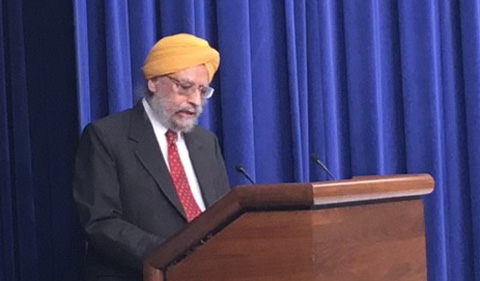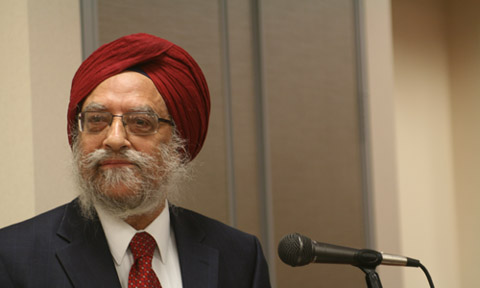Dr. Amritjit Singh gave a keynote address to a gathering of more than 125 Sikhs at a White House celebration of Guru Nanak’s birth-anniversary on Dec. 14.
“In recent weeks, tolerance has become the buzzword of public discourses in the United States and elsewhere. Guru Nanak would rather plead for mutual respect and understanding – going beyond mere tolerance,” Singh told the White House audience. Singh is Langston Hughes Professor of English at Ohio University.
The Economic Times reports that the Obama Administration used the celebration to assured the Sikh community “of their safety and security in the wake of a spur in hate crimes against the community following a shooting in San Bernardino that killed 14 people.”
“President Obama stands with you, he stands behind you and he stands in solidarity with [you]. And we all have a responsibility to remind Americans what makes us great,” said Valerie Jarrett, Senior Adviser to the President. “You are [a vital member] of our community and a big and vibrant part of what makes our country so great. So when your community comes under attack, we are all in danger,” she said.
Guru Nanak: Anticipating Du Bois and MLK by 400 Years
Singh’s keynote addressed “Guru Nanak: Equality and Social Justice.”
“Guru Nanak Dev is the first of the 10 spiritual leaders who developed a God-fearing, peace-loving community of Sikhs, literally ‘students’ or ‘followers,’ over 200 years, roughly between 1500 and 1700,” said Singh. “Guru Nanak (1469-1539) set the tone and direction of this distinctive formation through his amazing qualities as a teacher and guide.
“As I see it,” Singh continued, “the historical trajectory of Sikhism moved robustly toward the values enshrined in the U.S. Constitution – strong individualism and equality that cuts across caste, social class, and gender, as well as the freedoms guaranteed in our First Amendment.
“In many ways, Guru Nanak in his own times was a crusader for both civil rights and civil liberties. He anticipated by 400 years the struggle for African American civil rights led by Dr. W. E. B. Du Bois and NAACP in the early 20th century. And he preceded by 450 years Dr. Martin Luther King’s search in the 1960s for the ‘beloved community,’ a completely integrated society, a community of love and justice. In Sikh history, such a search would lead eventually to the very distinctive concept of Sant-Sipahi (the Saint-Soldier), integrating spiritual aspirations and social justice goals to form an egalitarian community that values love and compassion for all creatures as a manifestation of Divine Immanence.”
Singh noted that Guru Nanak expressed the need for “cultivating values and practices based not on sectarianism but on genuine devotion to God and his creatures…Guru Nanak’s message has special resonance for us today where fear and ignorance are giving rise to hatred, violence, and intolerance. The Guru had a sharp eye for the patterns of hypocrisy, intolerance, and exploitation that marked the religious expressions of holy men and religious leaders, princes and kings, merchants as well as bureaucrats. Millions of ordinary men and women, who depended upon the society’s elite for direction and protection, suffered without any recourse. And the Guru became a passionate, at times an angry, voice for these lowly people of his day.”
Singh explained that 200 years after Guru Nanak, the Tenth Master, Guru Gobind Singh (1666-1708) crystallized the ideal of the Saint-Solder. “The Saint-Soldier ideal is imbued with the goal of experiencing the Divine in human life, a strong commitment to family and children, a belief in the social equality of all men and women, and a readiness to fight for fairness and justice for all. These are the principles that had shaped the Sikh tradition from its beginnings with Guru Nanak Dev.”
‘Ambassadors for Guru Nanak’s Message in our Lives’
“Please allow me to close with my favorite story from the Guru’s travels that I believe is quite relevant to this gathering of diverse Americans, both U.S.-born and new immigrants,” Singh said.
“Guru Nanak and [his Muslim traveling companion] Mardana came to a town where the residents did not give them shelter and jeered at them instead. They left the place as the Guru waived a blessing, ‘May you live here forever!’ In the next town, they were welcomed and nicely treated. As they were leaving after a night’s stay, the Guru declared, ‘May this town be uprooted and its inhabitants scattered.’ Mardana, 10 years Guru’s senior, questioned the Guru’s strange justice. ‘Mardana,’ the Guru responded, ‘folks from the first town will take their bad ways to another place and corrupt it. When the residents of the second town move to new places, they will spread the truth and light they bring with them.’
“I find the story appealing not only for the Guru’s wit and wisdom, but also for the possibility that all of us who have chosen to scatter all over the earth as immigrants or have otherwise felt forced to migrate as refugees from war or hunger have the potential of doing good wherever we go by forming communities of compassion with others – Black or Asian, White or Hispanic. We can all be ambassadors for Guru Nanak’s message in our lives,” Singh said.



















6 Comments